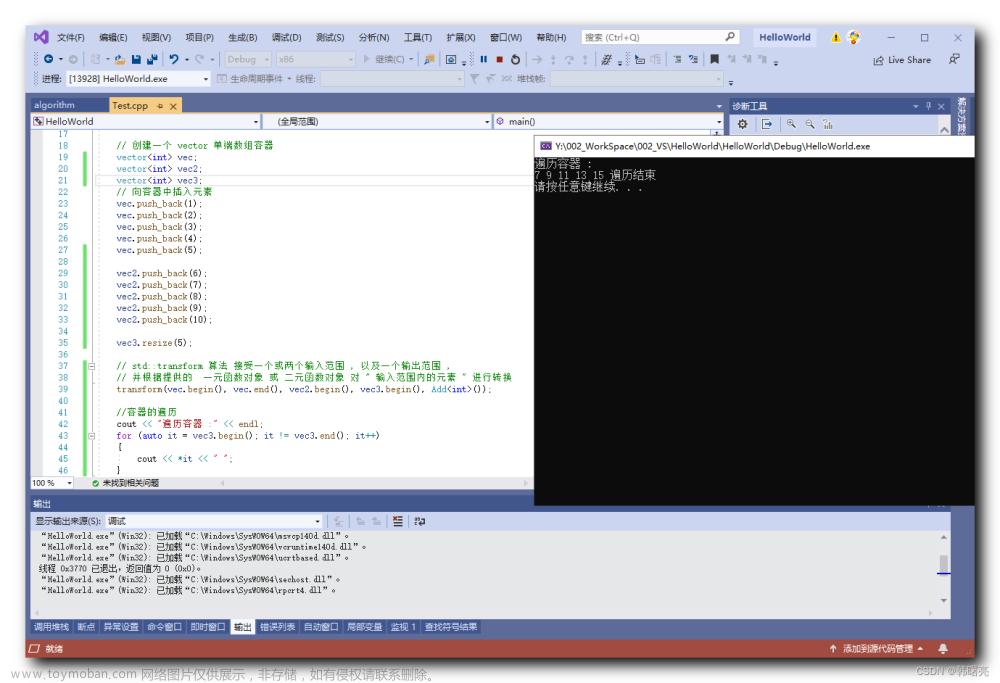函数原型
C++中std::tie函数的作用就是从元素引用中生成一个tuple元组,其在头文件<tuple>中定义,其函数原型如下:
template< class... Types >
std::tuple<Types&...> tie( Types&... args ) noexcept; //C++11起, C++14前
template< class... Types >
constexpr std::tuple<Types&...> tie( Types&... args ) noexcept;//C++14起
其中参数 args 为构造 tuple 所用的零或更多左值参数。其返回值为含左值引用的std::tuple对象。
作用和用法
1. 解包 tuple 和 pair
std::tie 可以用于解包 tuple 和 pair,因为 std::tuple 拥有从 pair 的转换赋值。
注:元组tuple可以将不同类型的元素存放在一起,可以理解为pair的扩展(pair只能包含两个元素,而tuple可以多个)。
std::tuple拥有从 pair 的转换赋值的主要原因就是:tuple的实现中重载了 operator=,其部分原型如下:
template< class U1, class U2 > tuple& operator=( const std::pair<U1, U2>& p );//C++11 起, C++20 前
因此,std::tie可以用于pair的解包:
std::set<int> set;
std::set<int>::iterator iter;
bool result;
std::tie(iter, result) = set.insert(value);//解包 insert 的返回值为 iter 与 result
std::tie(std::ignore, result) = set.insert(value);//使用std::ignore忽略insert的返回pair中的第一个元素
注:std::ignore 是令 std::tie 在解包 std::tuple 时作为不使用的参数的占位符使用,即忽略某些 tuple 中的某些返回值。
2. 批量赋值
std::tie 可以将多个变量的引用整合成一个 tuple,进而通过另外一个同类型的 tuple 进行批量赋值。
tuple<string, double, int> tup("idoit", 98.8, 1);
string name;
double score;
int rank;
//通过变量tup实现对name、score、rank的批量赋值操作
tie(name, score, rank) = tup;
3. 比较结构体
可以将结构体成员传入std::tie,从而实现结构体的比较。
struct S {
int n;
std::string s;
float d;
bool operator<(const S& rhs) const
{
// 比较 n 与 rhs.n,
// 然后为 s 与 rhs.s,
// 然后为 d 与 rhs.d
return std::tie(n, s, d) < std::tie(rhs.n, rhs.s, rhs.d);
//注:由于tie返回的是一个 tuple,tuple的实现已经重载了operator<,因此可以利用tuple的operator<,进而实现结构体S的operator<。
}
};
具体示例
#include <iostream>
#include <set>
#include <string>
#include <tuple>
using namespace std;
struct S {
int n;
string s;
float d;
bool operator<(const S& rhs) const {
// 比较 n 与 rhs.n,
// 然后为 s 与 rhs.s,
// 然后为 d 与 rhs.d
return tie(n, s, d) < tie(rhs.n, rhs.s, rhs.d);
}
};
int main() {
set<S> set_of_s;
S value1{42, "Test1", 3.14};
S value2{23, "Test2", 3.14};
set<S>::iterator iter;
bool result;
/************解包**********/
tie(iter, result) = set_of_s.insert(value1);
if (result) cout << "Value1 was inserted successfully\n";
tie(std::ignore, result) = set_of_s.insert(
value2); // 使用std::ignore忽略insert的返回pair中的第一个元素
if (result) cout << "Value2 was inserted successfully\n";
/***********结构体比较**********/
bool r = value1 < value2;
cout << "value1 < value2 : " << r << endl;
/***********批量赋值**********/
tuple<string, double, int> tup("idoit", 98.8, 1);
string name;
double score;
int rank;
tie(name, score, rank) = tup;
cout << name << " " << score << " " << rank << endl;
return 0;
}
输出结果:文章来源:https://www.toymoban.com/news/detail-447893.html
Value1 was inserted successfully
Value2 was inserted successfully
value1 < value2 : 0
idoit 98.8 1
文章首发公众号:iDoitnow如果喜欢话,可以关注一下文章来源地址https://www.toymoban.com/news/detail-447893.html
到了这里,关于C++ std::tie函数详解的文章就介绍完了。如果您还想了解更多内容,请在右上角搜索TOY模板网以前的文章或继续浏览下面的相关文章,希望大家以后多多支持TOY模板网!









